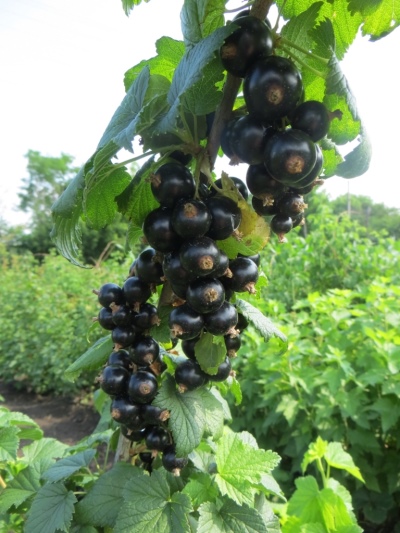
- Authors: Scotland
- Name synonyms: Big Ben
- Ripening terms: mid-late
- Growth type: medium-sized
- Yield: high
- Appointment: universal
- Berry weight, g: 2-3 (up to 7)
- Tasting assessment: 4,9
- Escapes: vertical
- Berry color: bluish-black
This variety of currants was created specifically for fresh consumption. It is a pity to process such a berry or freeze it, it is so fragrant, large, with a very thin skin and a pronounced currant taste. We are talking about a blackcurrant called Big Ben.
Breeding history
The crop was bred relatively recently, in 2008. The originator of the variety is the Scottish Agricultural Institute. A synonym for the name is Big Ben. The crop is intended for cultivation both in amateur gardening and for farms in the production of small volumes.
Description of the variety
Big Ben is a medium-sized currant crop. It has a bush that is distinguished by its power, the shoots grow vertically. Plant height reaches one and a half meters.
Characteristics of berries
The berries are quite impressive in size, from 2 to 3 grams in weight, but 7-gram specimens are also found (if agricultural technology is at its best). The skin is strong and at the same time thin, it is not felt when eaten. The separation is dry, the fruits do not tend to crumble.
Taste qualities
The taste of the fruits of varietal currant is dessert. Differs in sweetness and characteristic aroma. The variety is universal in purpose (the fruits behave well when frozen, are suitable for canning), but still, the taste of the berries can be felt best when eaten fresh. The tasters gave a high rating to this variety - 4.9 out of 5.
Ripening and fruiting
The culture is fast-growing, the harvest is harvested for 2 years, and in the third it becomes maximum.
The ripening dates for Big Ben currants are such that they are classified as mid-late crops. In the west of the Russian Federation, fruiting begins after the 2nd decade of June, and in the center - starting from the 25th or 28th of the same month.

Yield
The yield is high. So, a young plant brings up to 5 kilograms of berries, and more mature bushes, which are more than 3 years old, give 12 kg.
Growing regions
Considering that Big Ben officially has Scottish roots, the culture will feel best not in dry and hot, but in temperate climates. The middle lane and the center of the Russian Federation differ in just such conditions.
Landing
Planting culture is carried out, as a rule, in the classical way. Between the bushes 1-1.2 meters are kept. But the adjacent rows are located at a distance of 2-2.5 meters.

Growing and care
An overseas guest is quite demanding in her care.But this is forgiven her, given the high yield, as well as the magical taste of the berries.
Necessarily the formation of bushes of culture, as well as normalization. Thickening of the plantings should not be allowed: the berry will turn out to be sour and rather small. Therefore, the plant forms 7-9 shoots. At the same time, those shoots that have already borne fruit are cut off.
Mulching of shrubs with components of plant origin, such as straw, also takes place. This will save the root system from overheating, and the soil will not dry out. Thus, watering can be reduced.
Since the berries are quite heavy, farmers and simple gardeners recommend tying currant bushes of this variety. To do this, you can make a low, simple trellis.
From top dressing, the culture will need fertilizers with an increased content of elements such as potassium, calcium, phosphorus, but with a minimum of nitrogen during the flowering period, fruit ovary. However, at the start of the growing season, nitrogen will be needed.




Disease and pest resistance
Scottish currants are highly resistant to diseases and pests. So, Big Ben is resistant to such currant ailments as powdery mildew, leaf spot. The cultivar is resistant to kidney mites and red gall aphids.

Currant is one of the most favorite crops of gardeners, it can be found on almost any personal plot. In order for the currant berries to be tasty and large, and the bush itself to be healthy and strong, you should properly care for, treat and protect the plant from harmful insects. It is important to recognize the signs of the disease in a timely manner and begin treatment in the early stages of plant damage.
Resistance to adverse climatic conditions
The frost resistance of the Big Ben variety is quite high, and the variety is also drought-resistant. But if the drought continues for too long, it will affect the quality of the fruit. The culture is also distinguished by a rather high adaptability to any growing conditions.










































































